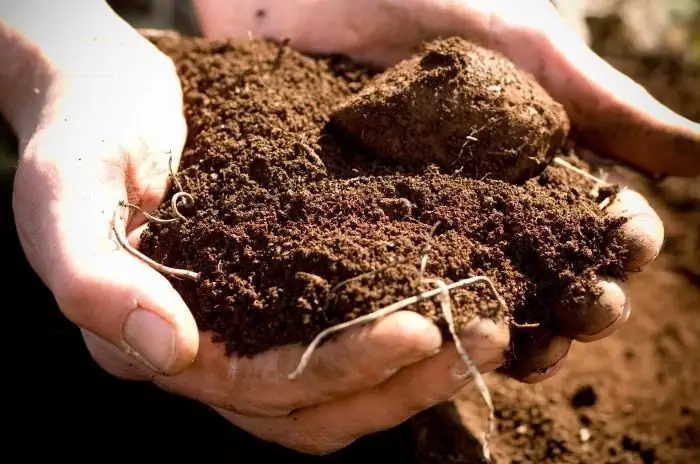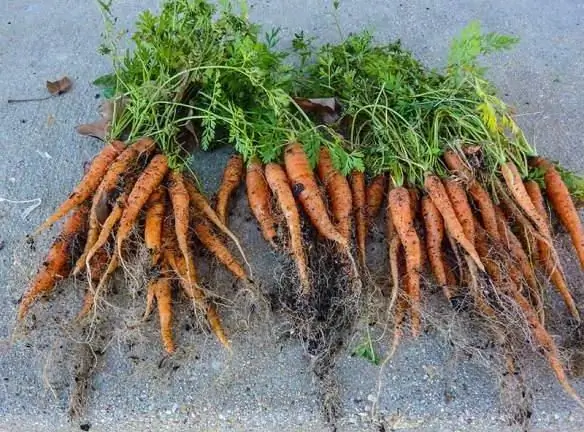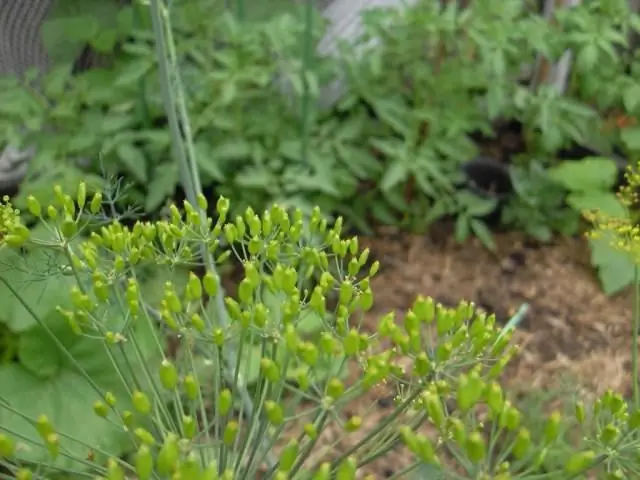2025 Author: Howard Calhoun | [email protected]. Last modified: 2025-01-24 13:10:39
Carrots are included in the main list of crops grown by Russian summer residents and gardeners. Like all root crops, this plant is not particularly demanding on development conditions, however, in order to get a rich harvest, it will not be superfluous to initially decide what kind of soil carrots love and correlate its requirements with the capabilities of a particular site. In addition, an orange root crop can coexist with other plantings. In particular, beds of carrots are often combined with beets, which have approximately the same requirements for soil nutrition. Here you can also include onions with dill, but, again, paying attention to the recommendations for growing them.
Soil for carrots

Loamy loose and sandy types of easily permeable soils are considered the most favorable for growing carrots. Another factor in the good development of the root crop will be the presence of humus (preferably a content of 4%), which will additionally nourish the carrots. What kind of soil does it loveplant in terms of acidity, it's easy to guess. This percentage should be as low as possible. When deviating from the norm, carrots lose their ability to resist diseases. It is also important to consider what crops were grown on the site before carrots. As practice shows, the root crop shows good development in places where tomatoes, potatoes, cabbage, legumes and greens used to bear fruit. It is also worth noting that carrots can be planted on the same soil only after 4 years.
Optimal growth conditions
Carrots do not belong to light-loving crops, however, a minimum level of illumination should be provided. If you grow this plant in the shade, then the development of the fruit will be slow, and the yield itself will noticeably decrease. If soil is being prepared for carrots in open ground, then it is necessary to provide for the absence of sharp drops and slopes. The optimal density of the soil layer is 0.65 grams per 1 cm3. In highly dense and insufficiently cultivated land, carrots bear fruits of non-standard branched forms, while yields are reduced, not to mention taste.
Indicators of humidity are also significant. Unlike many vegetable crops, carrots do not tolerate excessive moisture. This is reflected in the root system, which in such conditions is subject to diseases. Determining what kind of soil is needed for carrots in this regard, you can immediately refer to the groundwater level. If it is high, then the beds should be made appropriate - with a minimum height of 35 cm.
Preparing soil for carrots

The soil for sowing the root crop should be prepared in August. For 1 m2 it is necessary to lay about 3 kg of sawdust, which were infused in a solution of urea before use. The calculation should be done in this way: 1 matchbox of urea per 1 bucket of water, as well as half a bucket of sand and ventilated peat. In addition, granulated superphosphate (2 matchboxes), lime (100 g), potash fertilizers (1 box) and half a box of sodium nitrate should be added. It should be borne in mind that the soil for carrots in the open field must be properly dug up before sowing. This should be done with a spade bayonet to the full depth, after which the surface should be leveled with a rake, sprinkled with ash and moistened a little.
On sandy soil, it is also recommended to add one bucket of peat, humus and loamy soddy soil per 1 m22. Poor soils need to be fertilized with humus from autumn with the addition of potassium chloride and superphosphate. This is the only way to get a more or less decent harvest on it. And now let's move on to a detailed description of the fertilizers that are used for carrots on different types of soil.

Fertilizers for soil under carrots
Peat, compost and humus can be immediately added to the list of the most favorable soil fertilizers for carrots. The basis is a mineral additive, thanks to which the question of what kind of soil is needed for carrots will disappear. A properly prepared composition will endow any earth with the necessary trace elements. So, mineral fertilizerincludes 1 tsp. carbamide or sodium nitrate, 1 tbsp. l. powdered superphosphate in powder form and potassium chloride. When applying this fertilizer, the soil should be dug up at a depth of about 30 cm. Then the beds should be compacted and leveled. Depending on the type of soil, the following additives should also be used:
- Peat soil - half a bucket of coarse sand (preferably river sand), 4 kg of compost and a bucket of turf.
- Clay soil - a bucket of peat with coarse sand and 4 kg of humus.
- Light loamy soil - similar to clay composition of peat and humus (without sand).
- Sandy soil - half a bucket of humus, 2 buckets of turf with peat and 1 tbsp. l. specialized fertilizer with humic substances and trace elements.
- Chernozem soil - you can do without fertilizers, but applying 2 tbsp. l. powdered superphosphate will not be superfluous.
Soil for beets

Successful growth of beets will provide loam saturated with humus. But you can remember what kind of soil carrots love if they are properly fertilized - its development is possible on any land with suitable conditions. Same is the case with beets. The only type that makes it difficult to grow is heavy clay soil. Without abundant watering, root crops will be very bitter, so it is important to control the level of moisture. In general, beets are not particularly demanding on the soil - they need a moderate supply of microelements, provided that the acidity is not too high. For example, a good harvest is possible on slightly acidic soil.
To prepare the soil, it is necessary to carry out deep digging in the fall. In this case, the processing should be carried out in two stages: first - to disc, and after a month - to plow. By spring, the earth should be loosened and leveled. Floodplain soil for carrots and beets also requires additional surface digging. In this case, the beds are also made high due to the close passage of groundwater.
Fertilizers for beetroot soil
Nutritional supply of the soil is also done with mineral fertilizers in the spring. For 1 m2 you will need about 35 g of superphosphate powder, 15 g of ammonium nitrate and the same amount of potassium chloride. Poor soil is recommended to fill with organic additives, but this is already in the fall. This fertilizer is long-acting, so it will be possible to sow beets only after 2 years. Otherwise, the roots will not get enough nutrition.
Speaking about what kind of soil carrots and beets love, it is important to note the differences in the approaches to fertilizing these root crops. So, one of the basic components of fertilizer in the case of carrots is manure. For beets, it is not recommended. But this plant, like carrots, prefers moderate lighting and does not like shade.
Onion soil

Sunny places are also suitable for onions. However, from the hopelessness of the beds with it, you can equip it in light partial shade, the main thing is to avoid lowlands. It is very important that the soil has the opportunity to warm up and is fertile. The best option for onions is moderately moist,breathable and non-acidic loam. Again, you can turn to the question of what kind of soil carrots love and in what conditions it develops better. The main enemy is acidic soil. It is the same with onions, for planting which the earth with high acidity must be limed 2-3 years before use.
When choosing a planting site for this plant, crop rotation is also quite significant. The most favorable predecessors include tomatoes, cucumbers, cabbage, as well as other crops for which a suitable fertilizer was used. If we talk about the neighborhood, then it is better not to find carrots for this role for onions. The calculation of which soil for carrots is suitable in the context of compatibility with onions is simple - you can stop at loam with the appropriate fertilizer. As a result, the combination will provide good yields and mutual protection from pests.
Fertilizing soil for onions
Fertilizers of organic origin should be applied in autumn: for 1 m2 fill 5 kg of compost with humus and 1 kg of ash. Also, this supplement can be combined with mineral components. Like beets, onions do not like fresh manure, so you should exclude them if carrots are planted nearby. It’s already clear what kind of soil the onion loves - it’s loam, so you should focus on complex fertilizers. For example, use a combination of 20 g of powdered superphosphate and 10 g of potassium in the autumn, and in the spring, reinforce the composition with ammonium nitrate as a supplement. It is desirable to introduce mineral components shallowly, since the onion root system may simply not receivethe right substances.
Dill soil

Loose neutral soil is suitable for dill, heavy soil is not recommended. The preparation of the beds should begin in the fall - this will create the conditions for early sowing in the spring. You should also dig the earth 20 cm deep. If plantings are planned next to root crops, then it is worth considering what kind of soil carrots or beets love. Dill also prefers a flat surface with 2 cm grooves, while leaving 20 cm between rows. It is recommended to moisten the soil before sowing, and sprinkle loose earth on top, making a slight compaction. In the future, it is not necessary to water the seeds, since water can carry them into the soil.
Fertilizer for dill soil

Even before sowing, fertilizer must be applied to the ground: half a bucket of humus per 1 m2 with the addition of nitrophoska. When choosing other compositions, it is necessary to take into account what kind of soil carrots, onions, dill and beets love, of course, if they are planned to be grown in one area. The fact is that dill does not tolerate calcareous earth and additives in the form of ash, which are often used when filling the soil for root crops. For optimal feeding, you should look for universal fertilizer recipes that will not harm the neighbors in the garden and at the same time can ensure the good development of dill. For example, humus, which is not recommended for onions, can be replaced with mullein diluted with water. You can do the same with othercomponents - there is always an alternative.
Recommended:
Step-by-step feeding of onions

Any plant needs care, and any care for it consists of watering, weeding, fertilizing and loosening. This also applies to onions. Therefore, feeding onions is an important step in caring for them. In this article we will tell you how and when to fertilize onions, and as always, we will give tips and tricks
Soil analysis - a comprehensive assessment of the state of the soil cover

Due to man-made activities, the soil becomes a place of storage of a large amount of harmful substances. Soil analysis is used to assess the general ecological state and safety of the soil cover, determine the chemical composition and suitability for agricultural activities
Diseases of onions. How not to lose the harvest?

The article discusses the main diseases and pests of onions. Onion fly and downy mildew. How to prevent crop failure. Pest Control Tips
Preparing the onion for planting on the head. Preparing onion sets before planting. Preparing the soil for planting onions in spring

Each of the housewives knows that there should always be onions in the house. This product is added to almost any dish, it can bring great benefits to our body
Fertilizer for carrots and its proper cultivation

Carrot is a rather undemanding plant. Almost all rural residents are engaged in its cultivation. This is a fairly common culture in suburban areas. Getting a good crop of carrots is not too difficult. However, for this, of course, it is necessary to have at least some idea of the basic rules of its agricultural technology

